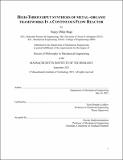High-Throughput Synthesis of Metal–Organic Frameworks in a Continuous Flow Reactor
Author(s)
Bagi, Sujay Dilip
DownloadThesis PDF (18.89Mb)
Advisor
Román-Leshkov, Yuriy
Terms of use
Metadata
Show full item recordAbstract
Metal–organic frameworks (MOFs) are promising materials for a wide range of applications given their chemical stability and structural tunability. MOFs are crystalline coordination complexes consisting of organic linkers and inorganic polynuclear metal clusters forming highly ordered 2D and 3D structures. The past decade has seen an exponential growth in the number of new MOF structures reported in the literature and their potential applications in water harvesting, carbon capture, gas storage, catalysis, separation, among others. A major bottleneck in widespread deployment of MOF-based platforms stem from the high cost of synthesis in traditional batch reactors that use excess solvents, require long crystallization times, suffer from low yields and intrinsic inefficiencies in heat/mass transfer processes. This thesis focuses on developing low-cost, high-throughput and energy-efficient synthesis routes using a continuous flow reactor for MOFs used in Atmospheric Water Capture (AWC) and Zr MOFs with coordinatively unsaturated open metal sites.
The first part of the thesis describes the modules used in the flow reactor platform, design of heated reaction zone (crystallizer), injection strategies for viscous reaction mixtures and scale-up scenarios. The flow platform is then used to develop a continuous manufacturing process for MOF808—a Zr-MOF widely studied as a catalyst and an adsorbent in industrially important processes—that can achieve high process yields with minimal solvent use. Under flow optimized conditions (150 °C, 5 min), the N,N-dimethylformamide solvent and formic acid modulator amounts were decreased by 84% and 67% in volume, respectively, and resulted in an increase in productivity (defined in units of kgₘₒ subscript f m⁻³day⁻¹) by two orders of magnitude with similar yields, compared to the established batch synthesis (130 °C, 48 hours). A techno-economic model based on laboratory-demonstrated synthesis routes was developed to compare energy and cost savings for the flow system compared to batch, indicating that solvent use was the largest contributor to the overall cost. The flow platform was then used to evaluate the kinetics of crystallization for MOF-808 using time resolved powder X-ray diffraction measurements. The role of temperature and linker concentration on MOF-808 crystallization were investigated by determining the rate constants for nucleation (kₙ) and growth (k subscript g), which are obtained from nonlinear fitting of the crystallization curves with the Gualtieri model. The activation energies obtained using Arrhenius plots for nucleation (Eₐ(N)) and growth (Eₐ (G)) are 64.7 ± 4 kj mol⁻¹ and 59.2 ± 5 kj mol⁻¹ respectively. The use of higher flow rates at the same residence time and temperature resulted in higher crystal sizes with a narrow CSD—a simpler route for controlling crystal sizes. Finally, the flow platform is employed for process intensification of Ni₂Cl₂(BTDD) MOF synthesis—an optimal candidate for AWC which has tremendous potential to address global shortage of clean drinking water. Flow synthesis achieved higher yields, reduced solvent volume by ~50% with a simultaneous increase in process productivity by 3-fold. A computational fluid dynamics (CFD) model was developed to quantitate productivity enhancements in the flow reactor based on improved heat-transfer rates, larger surface-area to volume ratios, and effective residence times. This work adds critical facets to the growing body of research suggesting that the synthesis of MOFs in flow reactors offers unique opportunities to increase production rates and reduce synthesis costs.
Date issued
2021-09Department
Massachusetts Institute of Technology. Department of Mechanical EngineeringPublisher
Massachusetts Institute of Technology